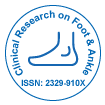Foot and Ankle Disorders: Causes, Diagnosis and Management
*Corresponding Author: Dr. Anu Mehra, Department of Orthopedics and Regenerative Medicine, University of JNU, India, Email: anu.mehra@gmail.comReceived Date: Mar 03, 2025 / Accepted Date: Mar 30, 2025 / Published Date: Mar 30, 2025
Citation: Anu M (2025) Foot and Ankle Disorders: Causes, Diagnosis andManagement. Clin Res Foot Ankle, 13: 636.
Copyright: © 2025 Anu M. This is an open-access article distributed under theterms of the Creative Commons Attribution License, which permits unrestricteduse, distribution, and reproduction in any medium, provided the original author andsource are credited.
Abstract
Foot and ankle disorders represent a significant proportion of musculoskeletal complaints and can affect individuals across all age groups. These disorders range from acute injuries to chronic degenerative conditions and can severely impair mobility and quality of life. This article aims to provide a comprehensive overview of the most common foot and ankle disorders, their underlying causes, diagnostic approaches, and current management strategies including conservative, surgical, and rehabilitative options. Foot and ankle disorders encompass a wide spectrum of conditions affecting the bones, joints, ligaments, tendons, and muscles of the lower extremity. These disorders are among the most common musculoskeletal complaints and can significantly impair mobility, quality of life, and independence across various age groups. The foot and ankle complex serves not only as a critical foundation for weight-bearing and locomotion but also plays a pivotal role in maintaining balance and posture. Disorders in this region may arise from acute injuries, chronic overuse, degenerative changes, systemic diseases, congenital abnormalities, or biomechanical imbalances. Common conditions include plantar fasciitis, Achilles tendinopathy, ankle sprains, flatfoot deformities, hallux valgus (bunions), arthritis, and fractures, each presenting unique challenges in diagnosis and management. Advancements in diagnostic imaging, conservative therapies, surgical interventions, and rehabilitative strategies have transformed the approach to foot and ankle care. However, early recognition and appropriate management remain essential to prevent long-term complications, such as chronic pain, deformity, and disability. This paper aims to provide an in-depth overview of the etiology, clinical presentation, diagnostic techniques, and evidence-based treatment options for prevalent foot and ankle disorders. Emphasis is placed on interdisciplinary approaches involving orthopedics, physiotherapy, podiatry, and sports medicine to optimize patient outcomes and functionality. The review also explores emerging trends in regenerative medicine, minimally invasive surgery, and the role of biomechanical assessment in preventing recurrent injuries.

 Spanish
Spanish  Chinese
Chinese  Russian
Russian  German
German  French
French  Japanese
Japanese  Portuguese
Portuguese  Hindi
Hindi 
